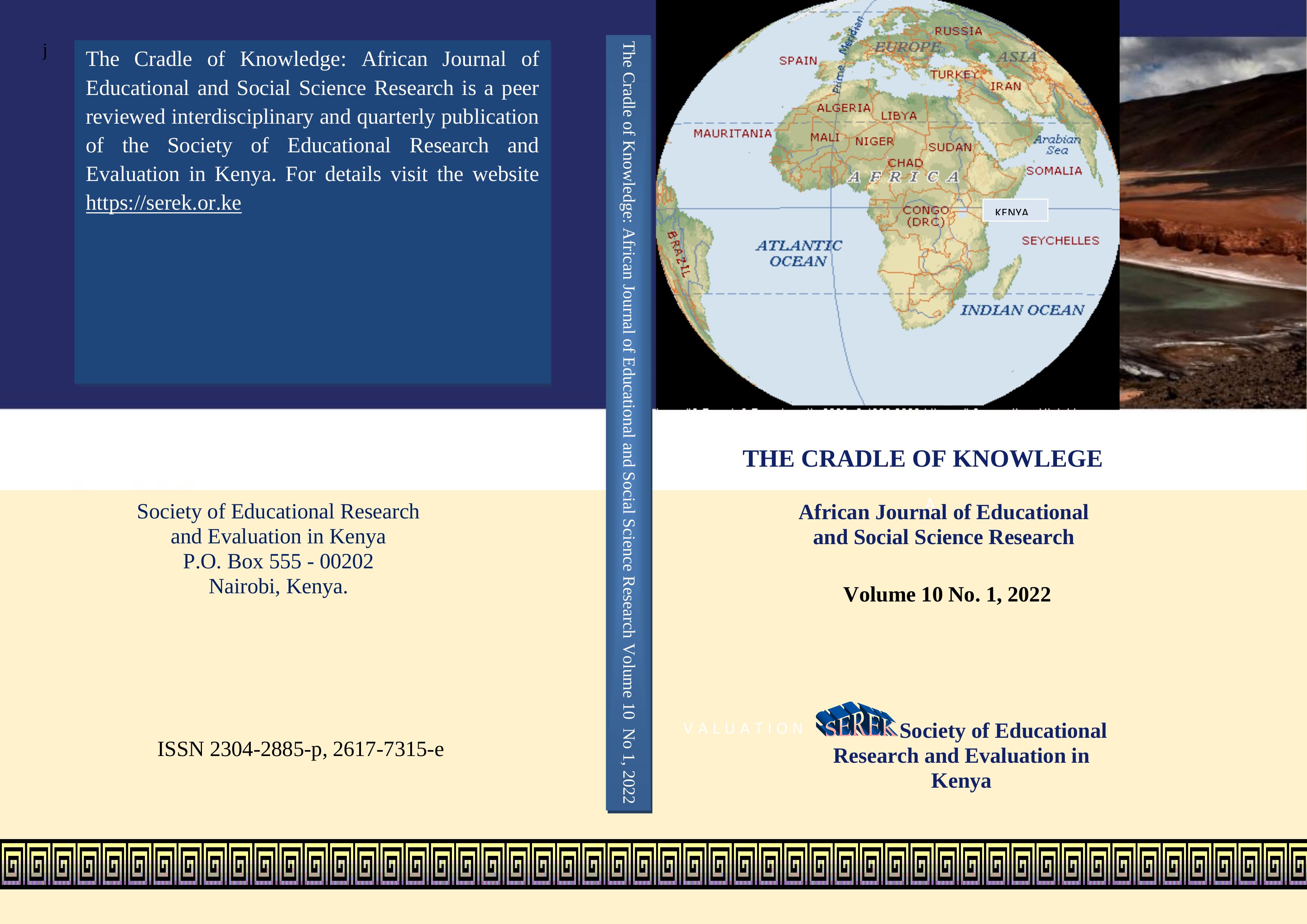
Influence of Ethnic Conflicts on Occupational Structure among Households in Tana Delta Sub-County, Tana River County, Kenya
Abstract
Globally ethnic conflicts are a familiar scene with 1.5 billion people living in conflict-affected countries. Ethnic conflicts manifest in different ways including; ethnic killings and a lack of social cohesion. The African continent experiences 30% of the conflicts in the world, with Kenya being one of the African countries with high conflict incidences. In 2017, 21.4% of the population experienced conflict with Tana delta, a Sub-county in Tana River County experiencing most of the ethnic conflicts. The purpose of the study was to determine the influence of ethnic conflicts on occupational structure in the Tana delta sub-county. The study employed a cross-sectional survey design and data was collected from the sub-county from a sample of 120 household heads. Stratified proportionate and simple random sampling techniques were used to select the 120 participants across the 17 locations in the sub-county. A researcher-administered semi-structured questionnaire was used to collect both qualitative and quantitative data. Data was analysed by running both descriptive and inferential tests statistics. Descriptive tests run included percentages, means, and frequencies were used to provide facts while a partial correlation was run to support making the inferences. This study established a partial correlation coefficient of -.314 with p< 0.001. This indicated a moderate relationship and statistical significance between ethnic conflicts and occupational structure. Therefore the null hypothesis that ethnic conflicts have no statistically significant influence on occupational structure in the Tana Delta sub-county was rejected. This means ethnic conflicts influence the occupational structure of the Tana delta sub-county. In addition, the correlation coefficient of -.314 means that, as the number of ethnic conflicts increases the occupation structure is negatively affected and vice versa. This means with the increase in conflict incidences, the affected area cannot transition its economy from primary to manufacturing and tertiary levels of development. These findings may be useful to peace actors in the sub-county including the county and national government, and faith-based and non-governmental organizations in designing peace-building interventions towards an improved occupation profile.
Keywords: Ethnic conflict; influence; monetary poverty; occupational structure
Full Text:
PDFReferences
Armed Conflict Location & Event Data Project (ACLED). (2019). Guide to Dataset Use for Humanitarian and Development Practitioners. https://reliefweb.int/report/world/armed-conflict-location-event-data-project-acled-guide-dataset-use-humanitarian-and-0
Armed Conflict Location & Event Data Project ACLED. (2017). Conflict Trends (No. 55): Real-Time Analysis of African Political Violence, February 2017. https://reliefweb.int/report/world/conflict-trends-no-55-real-time-analysis-african-political-violence-february-2017
Bakken, I. V., & Rustad, S. A. (2018). Conflict Trends in Africa, 1989–2017, Conflict Trends, 6. Oslo: PRIO. https://www.prio.org/Publications/Publication/?x=11048
Bocha, G. (2017, November 26). Rights body urges government to release report on Tana Delta killings. Daily Nation. https://www.nation.co.ke/counties/tana-river/Publish-report-Tana-Delta-killings/3444928-3443452-o0r567/index.html
Chauvin, N. D., & Rohner, D. (2009). The Effects of Conflict on the Structure of the Economy. In Proceedings of the German Development Economics Conference, Frankfurt 2009, No. 6. https://ideas.repec.org/p/zbw/gdec09/6.html
Chebunet, K. P., Adome, J. L., & Abonyo, J. C. L. (2013). Cultural Beliefs as a Source of Ethnic Conflicts : A Study of the Turkana and Pokot Pastoralists of Kenya, 1(June), 1–13. http://ir.mu.ac.ke:8080/xmlui/handle/123456789/915
Cortina, J. M. (1993). What Is Coefficient Alpha? An Examination of Theory and Applications. The Journal of Applied Psychology, 78(1), 98–104. https://doi.org/10.1037/0021-9010.78.1.98
Divisha. (2016). How Occupational Structure Changes with Economic Development. http://www.sociologydiscussion.com/population/how-occupational-structure-changes-with-economic-development/3178
Dowd, C., & Raleigh, C. (2013). ACLED country report: Kenya. http://www.acleddata.com/wp-content/uploads/2014/10/ACLED-CountryReport_Kenya_December-2013_updated.pdf
Emmanuel, D., Seidu, A., & Owusu-Mensah. (n.d.). The cost of inter-ethnic conflicts in Ghana’s northern region: The case of the Nawuri-Gonja conflicts. Scholar Commons. https://scholarcommons.usf.edu/jacaps/vol3/iss1/
Hertzog, M. A. (2008). Considerations in determining sample size for pilot studies. Research in Nursing & Health, 31, 180–191. https://doi.org/10.1002/nur.20247
Johanson, G., & Brooks, G. (2010). Initial Scale Development: Sample Size for Pilot Studies. Educational and Psychological Measurement, 70, 394–400. https://doi.org/10.1177/0013164409355692
Kenya National Commission for Human Rights (KNCHR). (2014). Are we under siege? The state of security in Kenya: an occasional report (2010 – 2014). Nairobi: KNCHR. http://www.ke.undp.org/content/dam/kenya/docs/Democratic%20Governance/State%20of%20Security%20in%20Kenya%20-Occassional%20Report.pdf
Kimenyi, M., Adibe, J., Jirgi, A. J., Kergna, A., Deressa, T. T., Pugliese, J. E., & Westbury, A. (2014). The Impact Of Conflict And Political Instability On Agricultural Investments. Africa Growth Initiative Working Paper 17 | July 2014. https://www.brookings.edu/wp-content/uploads/2016/06/14-07-22-Impact-of-Conflict-MaliNigeria_FINAL.pdf
Kipkemoi, S., Nyamasyo, G., Mari, N., & Musingi, J. (2017). Natural resource based conflicts in Tana River County, Kenya. International Academic Journal of Human Resource and Business Administration, 2(3), 599-610
Kirchner, K. (2013). Conflicts and Politics in the Tana Delta, Kenya, An Analysis of the 2012-2013 Clashes and the General and Presidential Elections 2013. https://openaccess.leidenuniv.nl/handle/1887/22835
Kivoto, M. E. (2014). Ethnic Conflict And Its Impact On Economic Development In Africa : A Case Study Of Kenya International Relations. https://www.academia.edu/11302119/Ethnic_Conflict_And_Its_Impact_On_Economic_Development_In_Africa_A_Case_Study_Of_Kenya
Mehta, P. (n.d.). Occupational Structure and Economic Development. http://www.economicsdiscussion.net/economics-2/occupational-structure-and-economic-development/2161
Ngozi, I. (2014). Impact of Cost of Conflict on Economic Development in Nigeria. International Journal of Open Scientific Research, 2, 13–31.
Oduor, S. (2021, January 19). Kenya: One dead in community clashes as tensions flare in Tana River. allAfrica.com. https://allafrica.com/stories/202101190359.html
Rohwerder, B. (2015). Conflict Analysis of Kenya. GSDRC, University of Birmingham., https://gsdrc.org/publications/conflict-analysis-of-kenya/
Schafer, H. (2018). The drivers of conflict: Where climate, gender and infrastructure intersect. World Bank. http://blogs.worldbank.org/dev4peace/drivers-conflict-where-climate-gender-andinfrastructure-intersect
Szayna, T. S., O’Mahony, A., Kavanagh, J., Frederick, B., Norlen, T. C., Watts, S., & Voorhies, P. (2017). Conflict Trends and Conflict Drivers: An Empirical Assessment of Historical Conflict Patterns and Future Conflict Projections. RAND Corporation., https://www.rand.org/pubs/research_reports/RR1063.html
Vannice, C. (2017). Bringing Clarity to Crisis. Armed Conflict Location & Event Data Project: Kenya-June 2017 update. https://www.acleddata.com/2017/07/17/kenya-june-2017-update/
Refbacks
- There are currently no refbacks.

This work is licensed under a Creative Commons Attribution 4.0 International License.
SEREK publication https://serek.or.ke
This work is licensed under a Creative Commons Attribution 4.0 International License